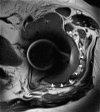Corrosion at the head-neck taper as a cause for adverse local tissue reactions after total hip arthroplasty
- PMID: 23289127
- PMCID: PMC3444948
- DOI: 10.2106/jbjs.k.01352
Corrosion at the head-neck taper as a cause for adverse local tissue reactions after total hip arthroplasty
Abstract
Background: Corrosion at the modular head-neck junction of the femoral component in total hip arthroplasty has been identified as a potential concern, although symptomatic adverse local tissue reactions secondary to corrosion have rarely been described.
Methods: We retrospectively reviewed the records of ten patients with a metal-on-polyethylene total hip prosthesis, from three different manufacturers, who underwent revision surgery for corrosion at the modular head-neck junction.
Results: All patients presented with pain or swelling around the hip, and two patients presented with recurrent instability. Serum cobalt levels were elevated prior to the revision arthroplasty and were typically more elevated than were serum chromium levels. Surgical findings included large soft-tissue masses and surrounding tissue damage with visible corrosion at the femoral head-neck junction; the two patients who presented with instability had severe damage to the hip abductor musculature. Pathology specimens consistently demonstrated areas of tissue necrosis. The patients were treated with debridement and a femoral head and liner exchange, with use of a ceramic femoral head with a titanium sleeve in eight cases. The mean Harris hip score improved from 58.1 points preoperatively to 89.7 points at a mean of 13.0 months after the revision surgery (p=0.01). Repeat serum cobalt levels, measured in six patients at a mean of 8.0 months following revision, decreased to a mean of 1.61 ng/mL, and chromium levels were similar to prerevision levels. One patient with moderate hip abductor muscle necrosis developed recurrent instability after revision and required a second revision arthroplasty.
Conclusions: Adverse local tissue reactions can occur in patients with a metal-on-polyethylene bearing secondary to corrosion at the modular femoral head-neck taper, and their presentation is similar to the adverse local tissue reactions seen in patients with a metal-on-metal bearing. Elevated serum metal levels, particularly a differential elevation of serum cobalt levels with respect to chromium levels, can be helpful in establishing this diagnosis.
Figures




References
-
- Jacobs JJ, Urban RM, Gilbert JL, Skipor AK, Black J, Jasty M, Galante JO. Local and distant products from modularity. Clin Orthop Relat Res. 1995. Oct;(319):94-105 - PubMed
-
- Collier JP, Mayor MB, Williams IR, Surprenant VA, Surprenant HP, Currier BH. The tradeoffs associated with modular hip prostheses. Clin Orthop Relat Res. 1995. Feb;(311):91-101 - PubMed
-
- Cook SD, Barrack RL, Baffes GC, Clemow AJ, Serekian P, Dong N, Kester MA. Wear and corrosion of modular interfaces in total hip replacements. Clin Orthop Relat Res. 1994. Jan;(298):80-8 - PubMed
-
- Collier JP, Surprenant VA, Jensen RE, Mayor MB. Corrosion at the interface of cobalt-alloy heads on titanium-alloy stems. Clin Orthop Relat Res. 1991. Oct;(271):305-12 - PubMed
-
- Kop AM, Swarts E. Corrosion of a hip stem with a modular neck taper junction: a retrieval study of 16 cases. J Arthroplasty. 2009. Oct;24(7):1019-23 Epub 2008 Oct 5 - PubMed
Publication types
MeSH terms
Substances
Grants and funding
LinkOut - more resources
Full Text Sources
Other Literature Sources
Medical

